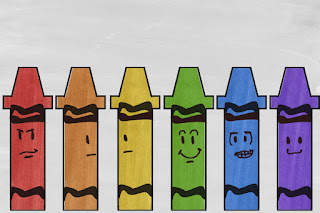Many of my students like to read. Many of them like to draw. Why not combine the two? This painting project was such a success with my second graders last year-it served as a fitting introduction to perspective and used a shape they are studying in math, the parallelogram. It also gave them a chance to use their imagination and express their interests, hobbies and personalities, which is always important in art! Keep reading for some tips on how to teach this sometimes confusing concept.
Before we began we learned a little about my all time favorite artist, Vincent Van Gogh. Students learn a lot more about him when they see me the following year in third grade - this is merely a brief introduction to him. His still life Blossoming Almond Branch in a Glass with a Book serves as our inspiration:
Step 1: Trace the parallelogram.
Yes, students start off with a tracer. Drawing a neat, symmetrical parallelogram at this age is very difficult at this age and even the most artistic kids struggle with this, leading to a lot of initial frustration early on. Giving students a tool to begin with helps their confidence and encourages them to really get into this project. Be sure not to miss the opportunity here to make connections to math! I like to talk to students about the number of angles on this shape and where the parallel lines are. They LOVE showing off their math knowledge to their art teacher!
Make sure students trace their parallelogram pointing towards the bottom of the page.
Step 2: Flip
Flip it over and trace neatly to make the book's other side.
Step 3: Finish the form
This step can be tricky. Have students line their ruler up with the middle vertex. They will draw a dot about 2.5 inches up. Students will then finish the form of their book by connecting this dot with each outer vertex. (Sounds complicated, I know. It's not!)
Step 4: Pages
Draw several parallel lines to create pages.
Step 5: Draw the desk
Step 6: Add a cover, title, and details!
This is where students get creative! I required students to draw at least two other items on the desk with their book. Some drew vases, cups, mugs, or even phones. We had been practicing with still life drawing for a previous project, so this step was easy for them.
This student replicated a Van Gogh painting on his cover. I LOVE this idea.
This student illustrated Harry Potter and the Order of the Phoenix! How cute is that phoenix?Here's a handout of all the steps:
To download these resources for absolutely free, visit my product listing at my Teachers Pay Teachers Store here.
And there you have it! Happy creating!

























